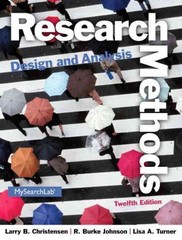Question
need the commands in R to complete the following question. The question is from chapter 7 of Introductory Econometric 5th edition, Wooldridge. C9) There has
need the commands in R to complete the following question.
The question is from chapter 7 of Introductory Econometric 5th edition, Wooldridge.
C9) There has been much interest in whether the presence of 401(k) pension plans, available
to many U.S. workers, increases net savings. The data set 401KSUBS.RAW contains
information on net financial assets (nettfa), family income (inc), a binary variable for
eligibility in a 401(k) plan (e401k), and several other variables.
(i) What fraction of the families in the sample are eligible for participation in a
401(k) plan?
(ii) Estimate a linear probability model explaining 401(k) eligibility in terms of
income,
age, and gender. Include income and age in quadratic form, and report
the results in the usual form.
(iii) Would you say that 401(k) eligibility is independent of income and age? What
about gender? Explain.
(iv) Obtain the fitted values from the linear probability model estimated in part (ii).
Are any fitted values negative or greater than one?
(v) Using the fitted values e?401k i from part (iv), define ?e401ki 5 1 if ? e401k $ .5 and ?401k 5 0 if ? e401k ? .5. Out of 9,275 families, how many are predicted to be
eligible
for a 401(k) plan?
(vi) For the 5,638 families not eligible for a 401(k), what percentage of these are predicted
not to have a 401(k), using the predictor ? e401ki? For the 3,637 families
eligible for a 401(k) plan, what percentage are predicted to have one? (It is helpful
if your econometrics package has a "tabulate" command.)
(vii) The overall percent correctly predicted is about 64.9%. Do you think this is a complete
description of how well the model does, given your answers in part (vi)?
(viii) Add the variable pira as an explanatory variable to the linear probability model.
Other things equal, if a family has someone with an individual retirement account,
how much higher is the estimated probability that the family is eligible for a
401(k) plan? Is it statistically different from zero at the 10% level?

Step by Step Solution
There are 3 Steps involved in it
Step: 1

Get Instant Access to Expert-Tailored Solutions
See step-by-step solutions with expert insights and AI powered tools for academic success
Step: 2

Step: 3

Ace Your Homework with AI
Get the answers you need in no time with our AI-driven, step-by-step assistance
Get Started


